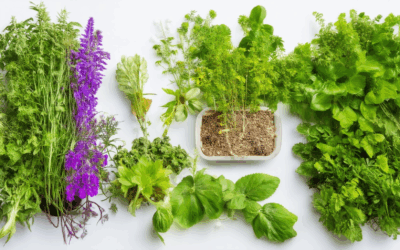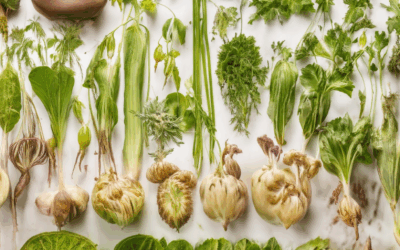In today’s fast-paced world, there’s something uniquely special about heirloom plants—those time-honored varieties passed down through generations. Not only do they offer a connection to our agricultural past, but they also play a crucial role in our food security and cultural heritage. Yet, identifying heirloom plants can feel like a puzzle waiting to be solved. From understanding their distinctive characteristics to decoding their classification, this journey reveals the depth of their history and the reasons behind their enduring popularity. Whether you’re a seasoned gardener or new to the world of heirloom varieties, mastering the art of heirloom plant identification opens up a world of unique flavors, resilience, and stories. In this article, we’ll explore everything you need to know, from recognizing the signs of an heirloom plant to understanding its rich history and the legal considerations surrounding their preservation. Let’s embark on this enlightening exploration together!
Key Takeaways
– Saving Heirloom Seeds: Heirloom seeds can be legally saved under certain conditions, such as being open-pollinated or non-GMO, but patented or proprietary seeds may require permission.
– Replanting Seeds: Replanting seeds from patented or protected varieties can infringe on intellectual property laws, impacting farmers’ rights and sustainability.
– Heirloom Tomatoes: Heirloom tomatoes are entirely legal, known for their open-pollination, non-GMO status, and rich flavors, making them a sustainable and flavorful choice for gardens.
What Are Heirloom Plants?
Heirloom plants are rare, non-hybrid varieties of vegetables, fruits, flowers, and herbs that have been passed down through generations. These plants are often distinguished by their unique traits, historical significance, and ability to reproduce naturally without the use of synthetic chemicals or genetic modification.
Characteristics of Heirloom Plants:
- Open-Pollination : Heirloom plants are typically open-pollinated, meaning they can reproduce naturally through pollination by insects or wind. This is a key distinction from hybrid varieties, which are often propagated through controlled pollination or genetic manipulation.
- Age : Heirloom plants are generally more than 50 years old. Many have been around for centuries, preserving traits that may have become lost in newer, hybridized varieties.
- Historical Context : Heirlooms often have a rich history tied to specific regions and cultures. They have been grown by families for generations, making them a valuable part of cultural heritage.
- Unique Traits : Heirloom plants are known for their distinct appearance, flavor, and resilience. They may have colors, shapes, or sizes that differ significantly from modern hybrids.
How to Identify Heirloom Plants:
- Check for Open-Pollination : Look for plants that do not require artificial pollination or treatments to set fruit. These are often self-fertile or rely on natural pollinators.
- Research Age and History : Investigate the origins of the plant. Older, traditional seed catalogs or historical records may indicate its age and cultural significance.
- Examine Unique Features : Notice distinguishing characteristics such as unusual colors, shapes, or growth patterns that suggest it is a heirloom variety.
Comparing Heirloom Plants to Modern Hybrids:
While heirlooms are celebrated for their naturalness and historical value, modern hybrid plants offer benefits like disease resistance and uniformity. However, many hybrids lack the diversity and unique qualities found in heirlooms.
Resources for Heirloom Enthusiasts:
- Grimm’s Gardens offers a comprehensive guide to heirloom vegetables, highlighting their benefits and how to grow them successfully.
- Seed Savers Exchange is another reputable source for heirloom seeds, providing detailed information on preserving and growing traditional varieties.
By understanding these characteristics and researching the history of a plant, you can determine whether it qualifies as an heirloom.
What Classifies a Plant as an Heirloom?
- Age and Tradition: Heirloom plants are typically decades or even centuries old, having been passed down through generations. Their longevity suggests a preference for preserving their unique traits.
- Genetic Stability: These plants are known for their genetic consistency, meaning they “breed true to type” from seeds, ensuring reliability in cultivation.
- Historical and Cultural Significance: Heirlooms often hold cultural or regional importance, reflecting traditional practices and values associated with their growth and consumption.
- Sustainability and Environmental Benefits: Heirloom plants contribute to biodiversity and ecological balance, often requiring less synthetic intervention and promoting sustainable agriculture. Learn more about heirloom gardening practices .
Are Heirloom Plants Usually 50 Years Old?
Heirloom plants are typically defined as plants that are at least 50 years old, often passed down through generations. These varieties are cherished for their unique traits and adaptability to specific regions. Unlike hybrid plants, which are bred for uniformity and ease of cultivation, heirlooms are often preserved for their distinct characteristics and historical significance.
While most heirlooms are indeed decades old, they can vary in age depending on their history and usage. Many heirloom varieties trace their origins back to pre-WWII times, reflecting a era of diverse plant breeding. These plants are highly valued by gardeners for their resilience and ability to thrive in various conditions.
Here’s a comparison between heirlooms and hybrid plants:
- Heirlooms: Typically 50+ years old, often preserving historical traits.
- Hybrids: Breeding focuses on modern traits like disease resistance and yield.
- Heirlooms: Open-pollinated, passed down through generations.
- Hybrids: F1 hybrids, often sterile or less fertile.
- Heirlooms: Better for organic gardening due to fewer chemicals.
- Hybrids: More reliant on synthetic fertilizers and pesticides.
For more information on heirloom gardening and sustainable practices, visit Old Seed .
Is It Illegal to Save Heirloom Seeds?
Saving heirloom seeds can be legal or illegal depending on the circumstances. Here’s a breakdown:
- Patented or Proprietary Seeds :
If the seeds you want to save are patented or belong to a company (e.g., hybrid or genetically modified varieties), saving them without permission may violate intellectual property laws. These seeds often come with specific agreements restricting their use and distribution. - Open-Pollinated Seeds :
Open-pollinated heirloom seeds are generally legal to save. These seeds reproduce naturally without human intervention, making them free from patent restrictions. Farmers and gardeners can easily collect and replant these seeds. - Non-GMO Heirlooms :
Non-genetically modified heirloom seeds are typically safe to save. However, always verify the seed’s origin and ownership to ensure compliance with local regulations. - Regional Laws :
Local laws may impose additional restrictions. Check with agricultural authorities in your area to understand any specific rules regarding seed saving. - Reputable Sources :
To avoid legal issues, purchase heirloom seeds from trusted sources that offer proper licensing when required. This supports lawful trade and respects intellectual property rights.
By understanding these factors, you can legally and ethically save heirloom seeds while contributing to biodiversity conservation.
Why is Replanting Seeds Illegal?
Replanting seeds is often restricted due to the protections afforded by intellectual property laws, particularly utility patents and the Plant Variety Protection Act (PVPA). These laws aim to safeguard innovations in seed development, ensuring that creators receive adequate compensation for their efforts. Here’s a breakdown of the key reasons:
- Utility Patents : Seeds can be patented, granting the owner exclusive rights for 20 years. During this period, the patented seeds cannot be reproduced, sold, or distributed without permission. This prevents unauthorized use and ensures the inventor recovers their investment.
- Plant Variety Protection Act (PVPA) : Under the PVPA, plant breeders gain protection for their creations. While farmers may have limited rights to replant seeds for non-commercial purposes, they typically cannot sell or distribute the seeds derived from these protected varieties.
- Terminator Technology : Some seeds are genetically modified to be sterile, further restricting their ability to be replanted. This technology prevents seed saving, reducing reliance on companies for future planting needs.
- Market Control : By limiting seed availability and forcing farmers to purchase new seeds annually, companies can maintain control over production costs and market distribution, influencing what is grown and how.
- Sustainability Concerns : The inability to replant seeds can lead to monocropping, reducing biodiversity and resilience in agriculture. This impacts soil health and the ability to adapt to changing conditions.
While these laws protect intellectual property, they also raise concerns about seed diversity and traditional farming practices. Exceptions may exist for small-scale farmers or non-commercial use, though specifics vary by region and legislation. Understanding these laws is crucial for farmers navigating the legal landscape of seed replanting.
Why Are Heirloom Tomatoes Illegal?
Heirloom tomatoes are not illegal. The term “heirloom” refers to open-pollinated tomato varieties that have been passed down through generations, preserving their unique genetics. These tomatoes are highly sought after for their rich flavors, diverse traits, and resistance to pests and diseases.
Myth vs. Reality
- Legality : Heirloom tomatoes are completely legal to grow, sell, and consume. There are no laws restricting their cultivation or distribution.
- Regulations : While some crops may be subject to specific regulations depending on location, heirloom tomatoes are not inherently illegal. They are often celebrated for their biodiversity and sustainability.
Benefits of Heirloom Tomatoes
- Open-Pollination : Heirloom tomatoes are open-pollinated, meaning they can be grown from seeds without synthetic chemicals, making them an eco-friendly choice.
- Non-GMO : As open-pollinated plants, heirloom tomatoes are naturally non-GMO, appealing to those seeking organic alternatives.
- Flavor and Variety : Their unique flavors and diverse shapes make them a favorite among chefs and home gardeners.
Growing Heirloom Tomatoes
- Popularity : Heirloom tomatoes are widely cultivated and appreciated for their resilience and culinary value.
- Sustainability : Many gardeners choose heirlooms for their ability to thrive in various conditions, reducing reliance on conventional farming methods.
Conclusion
Heirloom tomatoes are not illegal. They are a valuable crop for gardeners and a nutritious addition to diets worldwide. Their popularity stems from their historical significance and their adaptability to diverse growing conditions.








0 Comments